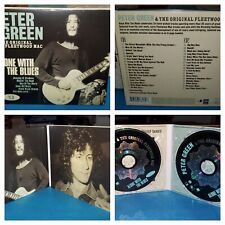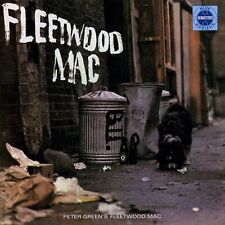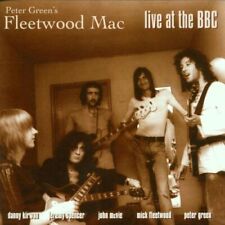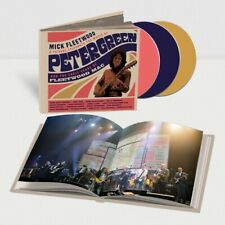|
1968
Blues Gonna Be My Only Way? Nineteen sixty-eight ushered in the age of Peter Green's Fleetwood Mac in Britain. It was the year that the band had its first encounter with commercial as well as critical success, owing largely to the phenomenon know as the British Blues Boom then sweeping that country. It was also the year that the band made its first, albeit very minor, scratch on the American charts. The year kicked off, after 1967's single-that-went-nowhere, "I Believe My Time Ain't Long", with an enormously successful debut album, Peter Green's Fleetwood Mac (titled simply Fleetwood Mac in America, it caused some degree of confusion seven years later when another album was released with the same title). It managed to chalk up thirteen months in the UK album charts, finally peaking at Number Four. It even briefly broke into Billboard's Top 200 Albums chart, despite the fact that, apart from the likes of Paul Butterfield, Mike Bloomfield, and a few others, the blues at this time was largely ignored by white American audiences. Peter Green's Fleetwood Mac was one of the best albums--both in terms of commercial appeal and committment on the part of the artist--to come out of the British Blues Boom. This was a purist album! Unlike other bands who claimed to be blues groups, or who played loud and called it "blues", Fleetwood Mac (the prefix "Peter Green's" was modestly dropped not long after the album's release) was just that; Green and Spencer writing totally convincing blues tracks in the best ethnic tradition of their mentors: B.B. King, Howlin' Wolf, Robert Johnson, and, of course, Elmore James, or performing cover versions of these greats that retained all of the credibility of the originals without being too rigid or over-reverent. Not bad for a debut! Also, it was about this time that Fleetwood Mac scored a Top 40 hit in the UK. "Black Magic Woman" remains to this day generally recognized as one of Green's finest blues pieces, thanks largely to the massive exposure that song got two years later when Carlos Santana and company recorded it for their second album Abraxis. In the UK, the B-side was one of Jeremy's Elmore James numbers, "The Sun Is Shining", but in the US this track was replaced with one from the album, "Long Grey Mare". It would take seven more years for the former song to be released stateside, and then only as part of the Vintage Years compilation. In July, the first indication of what direction Fleetwood Mac would take in the months to follow came in the form of "Need Your Love So Bad", an authentic blues number but also lavishly rearranged by Green, complete with strings and a more pop feel to it than any of their previous recordings. It also fared slightly better in the UK charts than "Black Magic Woman", lodging in at 31. As with the latter song, the British and American B-sides are different; the UK edition with a foreshadowing of the band's next LP, Mr. Wonderful , entitled "Stop Messin' Round", and the American edition with a cut from the first album, "No Place To Go". Mr. Wonderful , released only in the UK, was another album of hardcore blues, but this time perhaps less aesthetically pleasing than the first. This time out, the band recruited a horn section who, in an effort to emulate the sound quality of early US blues recordings, took Jeremy Spencer's advice to "just blow"--the end result being lots of off-key and out-of-tune playing mixed in with the good notes. Another major weakness of the record was Spencer's continuing love affair with All Things Elmore: what was exciting and invigorating on the first album tended to become tedious on the second. One could sum up this album by saying, despite many fine songs, this pursuit of authenticity bordered far too often on those great twin demons of the record industry: self-parody and self-indulgence. In other words, this was not necessarily a bad record, just a far too sloppy one. On the positive side, this album also included the services of John McVie's new wife, Christine Perfect, on piano, and labelmate Duster Bennett on blues harp (Green, Fleetwood, and McVie, returning the favor, guested on Bennett's album Smiling Like I'm Happy ). Mr. Wonderful also created some degree of controversy with its sleeve artwork, reflecting Fleetwood Mac's increasing sense of the outageous, depicting a dazed, nude (save for some strategically placed fig leaves) Mick Fleetwood clutching a doll. All of this was some months before either John Lennon and Yoko Ono's notorious Two Virgins album, or Blind Faith's infamous Blind Faith album sleeve. Not long after this album's release, Fleetwood Mac added another guitarist, Danny Kirwan (born May 13, 1950), from the London suburb of Brixton. Now that Fleetwood Mac became one of the very few bands to have not one but three lead guitarists, they went on to bigger and better things. One such "bigger thing" was "Albatross", an exquisitely beautiful low-key instrumental which topped the British charts early in the next year after having been used by the BBC as a television theme. But such a massive success and new-found popularity also brought cries of "Sellout!" from the band's more fanatical admirers who'd been following the band since its inception. Undaunted, the band went on their first US tour at the end of the year, using "Albatross" as its centerpiece. That song became their first single to get within kicking distance of Billboard's Top 100 singles, getting as high as 104. It was also their first single to have the same B-side on both sides of the Atlantic. In addition to this obviously hectic year in the life of Fleetwood Mac, its members also found time to guest on a number of other artists' LPs, including Eddie Boyd, Duster Bennett, and Gordon Smith.
|









